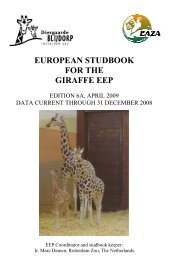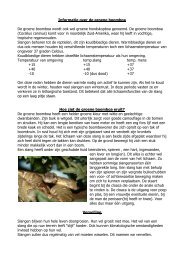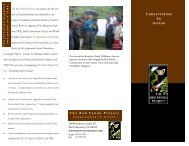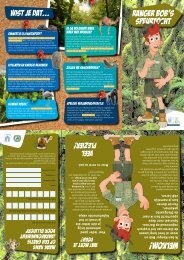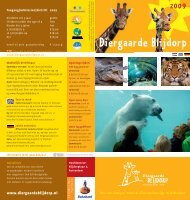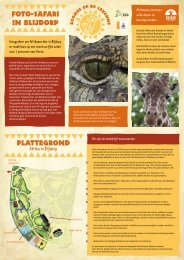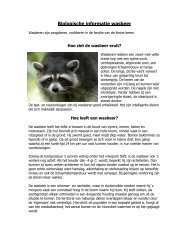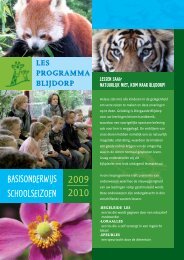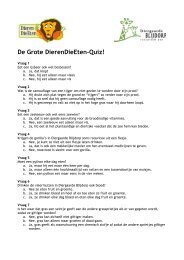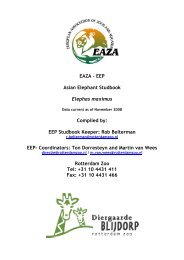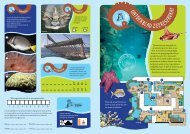Create successful ePaper yourself
Turn your PDF publications into a flip-book with our unique Google optimized e-Paper software.
<strong>EEP</strong> STUDBOOK CROWNED PIGEONS<br />
The second species: Pidgin: taro kong kong; scienftific: Xanthosoma sagittifolium), greens<br />
like e.g. "Aipeka", "kumu", sugar cane (Pidgin: suga; scientific: Saccharum officinarum),<br />
wild sugar cane (Pidgin: pitpit, scientific: Saccharum robustum) and yams (Pidgin: mami, or<br />
yam; scientific: Dioscorea esculenta). June and July are the months of the harvest jam and the<br />
dry season runs from September to December, which are the best months for hunting. The<br />
three groups make limited use of sago (Pidgin: saksak; scientific: Metroxylon rumphii), which<br />
is a staple food throughout much of the interior lowlands of New Guinea (Ruddle, et al.,<br />
1972). Their most important tree crops are betelnut (Pidgin: buai; scientific: Areca catechu),<br />
okari nuts, breadfruit (Pidgin: kapiak; scientific: Artocarpus altilis) and pandanus fruit<br />
(Pidgin: marita; scientific: Pandanus sp.). The Kamea trade lowland products for pandanus<br />
(Pidgin: karuka; scientific: Pandanus sp.), which is grown at higher altitudes.<br />
The Kovio have a more typical lowlands subsistence economy than their neighbours, which is<br />
based on hunting and fishing, harvesting sago and planting modest-sized gardens (some<br />
Pidgin and all scientific names: Mihalic, 1971).<br />
They make new gardens by cutting down primary forest. Firstly, they cut down the thick<br />
forest. Then they clear the soil by burning the cut trees and branches, and shortly afterwards<br />
they plant the food plants. In most villages women take care of the maintenance of the<br />
gardens and the harvesting. After the fertility of the old garden has run out, the men start<br />
cutting down new primary forest to make new gardens. The abandoned old gardens are left<br />
behind, which then developed into secondary forest. Sometimes, after 15 or 20 years, they reuse<br />
the same gardens.<br />
In addition, the men hunt wild animals to sustain their proteïn intake. They use traditional<br />
hunting methods like setting traps to catch wild animals and birds, using weapons like spears,<br />
bows and arrows. The people of Okovai have guns, which could be acquired by the contacts<br />
with the capital. Since 1996 it is not allowed to buy or sell weapons in Papua New Guinea,<br />
because of the high crime rate, but people who already own a gun (and have a license) still are<br />
able to buy bullets. Of course this decision makes the people without guns very angry, but for<br />
the wildlife of Papua New Guinea this situation is very fortunate. For example, the<br />
introduction of shotguns at Aibala (south of the Kunimaipa River in the Goilala sub-district,<br />
Central Province) has depleted animals and birds like the sulphur-crested cockatoo (Hallpike,<br />
1977). Local people borrow guns for a day for hunting and return them in the evening to the<br />
owner. People using bow and arrow are hunting wild pigs, cassowaries, wallabies, cuscus and<br />
fish. A few times they are also able to shoot a crowned <strong>pigeon</strong>, but the use of bows and<br />
arrows can not be a threat to the birds of Papua New Guinea. On the contrary, people using<br />
shotguns are able to shoot a wide variety of birds too, in addition to the already described<br />
mammals: like a lot of crowned <strong>pigeon</strong>s, blyths hornbills, brush-turkeys and cormorants. In a<br />
wide range around a village where people are using shotguns, there is no big game anymore.<br />
The use of shotguns clearly has reduced wildlife around the villages, but in the undisturbed<br />
parts of the Lakekamu Basin, there are still a lot of larger animals.<br />
Children also collect food from the rivers, like fish, eels and prawns. Sometimes they are able<br />
to catch a tortoise. Sometimes the villagers shoot a cassowary with one or two chicks. After<br />
shooting the mother, they catch the chicks and raise them like chickens in the villages. Once<br />
they are grown-up and start acting aggressive, they are killed and eaten by the people. This<br />
also happens to piglets if the mother is killed. Strange enough they do not domesticate pigs.<br />
There are more animals being kept as pets, for a longer or shorter period, like cuscus and tree<br />
kangaroos.<br />
133



